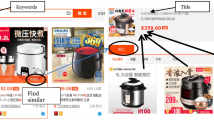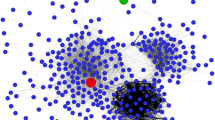Abstract
The online product recommendation networks (PRNs), connecting similar products with hyperlinks, have been widely implemented in user-generated content websites and ecommerce systems. With the PRNs as the virtual shelves, this paper explores the impact of the distance between products on the formation of product electronic Word-of-Mouth (eWOM). Employing an empirical book recommendation network of Amazon, the study one explores the effect of a focal product’s neighborhood (nearby others) on its eWOM, and study two explores the eWOM similarity between product pairs that are at one, two and three clicks away from each other. The results reveal the significant role played by the product distance on the association of their eWOM. On one hand, a focal product’s eWOM is largely influenced by that of its neighborhood. On the other hand, the good connectivity between two products, which is defined as the number of paths connecting them, is closely associated with the eWOM similarity between them. The findings suggest that the products should be considered as interactive collectives rather than separated individuals particularly in the eWOM studies.

Similar content being viewed by others
References
Desmet, P., & Renaudin, V. (1998). Estimation of product category sales responsiveness to allocated shelf space. International Journal of Research in Marketing, 15(5), 443–457.
Campo, K., & Gijsbrechts, E. (2005). Retail assortment, shelf and stockout management: Issues, interplay and future challenges. Applied Stochastic Models in Business and Industry, 21(4–5), 383–392.
Liang, T.-P., & Lai, H.-J. (2002). Effect of store design on consumer purchases: An empirical study of on-line bookstores. Information & Management, 39(6), 431–444.
Breugelmans, E., & Campo, K. (2011). Effectiveness of in-store displays in a virtual store environment. Journal of Retailing, 87(1), 75–89.
Hou, L., Liu, K., & Liu, J. (2017). Navigated random walks on amazon book recommendation network. In: International workshop on complex networks and their applications, Lyon, France (pp. 935–945).
Senecal, S., & Nantel, J. (2004). The influence of online product recommendations on consumers’ online choices. Journal of Retailing, 80(2), 159–169.
Breugelmans, E., Campo, K., & Gijsbrechts, E. (2007). Shelf sequence and proximity effects on online grocery choices. Marketing Letter, 18(1–2), 117–133.
Oestreicher-Singer, G., & Sundararajan, A. (2012). Recommendation networks and the long tail of electronic commerce. MIS Quarterly, 36(1), 65–83.
See-To, E. W., & Ho, K. K. (2014). Value co-creation and purchase intention in social networksites: The role of electronic Word-of-Mouth and trust–—A theoretical analysis. Computers in Human Behavior, 31, 182–189.
Kudeshia, C., & Kumar, A. (2017). Social eWOM: Does it affect the brand attitude and purchase intention of brands? Management Research Review, 40(3), 310–330.
Pan, X., Hou, L., Liu, K., & Niu, H. (2018). Do REVIEWS FROM FRIENDS AND THE CROWD AFFECT ONLINE CONSUMER POSTING BEHAVIOUR DIFFERENtly? Electronic Commerce Research and Applications, 29(3), 102–112.
Lin, Z., & Wang, Q. (2018). E-commerce product networks, word-of-mouth convergence, and product sales. Journal of the Association for Information Systems, 19(1), 23–39.
Furnham, A., & Boo, H. C. (2011). A literature review of the anchoring effect. The Journal of Socio-Economics, 40(1), 35–42.
Yang, Z., Zhang, Z. K., & Zhou, T. (2013). Anchoring bias in online voting. Europhysics Letters, 100(6), 68002.
Hou, L., Pan, X., Guo, Q., & Liu, J. G. (2014). Memory effect of the online user preference. Scientific Reports, 4, 6560.
Allsop, D. T., Bassett, B. R., & Hoskins, J. A. (2007). Word-of-mouth research: Principles and applications. Journal of Advertising Research, 47(4), 398–411.
Duan, W., Gu, B., & Whinston, A. B. (2008). Do online reviews matter? An empirical investigation of panel data. Decision Support Systems, 45(4), 1007–1016.
Shihab, M. R., & Putri, A. P. (2019). Negative online reviews of popular products: Understanding the effects of review proportion and quality on consumers’ attitude and intention to buy. Electronic Commerce Research, 19(1), 159–187.
Chevalier, J. A., & Mayzlin, D. (2006). The effect of word of mouth on sales: Online book reviews. Journal of Marketing Research, 43(3), 345–354.
Chintagunta, P. K., Gopinath, S., & Venkataraman, S. (2010). The effects of online user reviews on movie box office performance: Accounting for sequential rollout and aggregation across local markets. Marketing Science, 29(5), 944–957.
Li, X., & Hitt, L. M. (2008). Self-selection and information role of online product reviews. Information Systems Research, 19(4), 456–474.
Liu, Y. (2006). Word of mouth for movies: Its dynamics and impact on box office revenue. Journal of Marketing, 70(3), 74–89.
Dellarocas, C., Awad, N., & Zhang, M. (2005). Using online ratings as a proxy of word-of-mouth in motion picture revenue forecasting. Working paper, Smith School of Business. University of Maryland.
Clemons, E. K., Gao, G. G., & Hitt, L. M. (2006). When online reviews meet hyperdifferentiation: A study of the craft beer industry. Journal of Management Information Systems, 23(2), 149–171.
Godes, D., & Mayzlin, D. (2004). Using online conversations to study word-of- mouth communication. Marketing Science, 23(4), 545–560.
Hennig-Thurau, T., Gwinner, K. P., Walsh, G., & Gremler, D. D. (2004). Electronic word-of-mouth via consumer-opinion platforms: What motivates consumers to articulate themselves on the internet? Journal of Interactive Marketing, 18(1), 38–52.
Berger, J., & Iyengar, R. (2013). Communication channels and word-of-mouth: How the medium shapes the message. Journal of Consumer Reseasch, 40(3), 567–579.
Fu, J. R., Ju, P. H., & Hsu, C. W. (2015). Understanding why consumers engage in electronic word-of-mouth communication: Perspectives from theory of planned behavior and justice theory. Electronic Commerce Research and Applications, 14(6), 616–630.
Dixit, S., Badgaiyan, A. J., & Khare, A. (2019). An integrated model for predicting consumer’s intention to write online reviews. Journal of Retailing and Consumer Services, 46, 112–120.
Liu, Q., Zhang, X., Zhang, L., & Zhao, Y. (2019). The interaction effects of information cascades, word of mouth and recommendation systems on online reading behavior: An empirical investigation. Electronic Commerce Research, 19(3), 521–547.
Oestreicher-Singer, G., Libai, B., Sivan, L., Carmi, E., & Yassin, O. (2013). The network value of products. Journal of Marketing, 77(3), 1–14.
Goldenberg, J., Oestreicher-Singer, G., & Reichman, S. (2012). The quest for content: How user-generated links can facilitate online exploration. Journal of Marketing Research, 49(4), 452–468.
Oestreicher-Singer, G., & Sundararajan, A. (2012). The visible hand? Demand effects of recommendation networks in electronic markets. Management Science, 58(11), 1963–1981.
Leem, B., & Chun, H. (2014). An impact of online recommendation network on demand. Expert Systems with Applications, 41(4), 1723–1729.
Lin, Z., Goh, K. Y., & Heng, C. S. (2017). The demand effects of product recommendation networks: An empirical analysis of network diversity and stability. MIS Quarterly, 41(2), 397–426.
Huang, H. J., Yang, J., & Zheng, B. (2019). Demand effects of product similarity network in e-commerce platform. Electronic Commerce Research, 40, 1–31.
Carmi, E., Oestreicher-Singer, G., Stettner, U., & Sundararajan, A. (2017). Is Oprah contagious? The depth of diffusion of demand shocks in a product network. MIS Quarterly, 41(1), 207–221.
Chen, Y. L., Chen, J. M., & Tung, C. W. (2006). A data mining approach for retail knowledge discovery with consideration of the effect of shelf-space adjacency on sales. Decision Support Systems, 42(3), 1503–1520.
Chen, M. C., & Lin, C. P. (2007). A data mining approach to product assortment and shelf space allocation. Expert Systems with Applications, 32(4), 976–986.
Valenzuela, A., & Raghubir, P. (2009). Position-based beliefs: The center-stage effect. Journal of Consumer Psychology, 19(2), 185–196.
Valenzuela, A., Raghubir, P., & Mitakakis, C. (2013). Shelf space schemas: Myth or reality? Journal of Business Research, 66(7), 881–888.
Ert, E., & Fleischer, A. (2016). Mere position effect in booking hotels online. Journal of Travel Research, 55(3), 311–321.
Won Jeong, S., Fiore, A. M., Niehm, L. S., & Lorenz, F. O. (2009). The role of experiential value in online shopping: The impacts of product presentation on consumer responses towards an apparel web site. Internet Research, 19(1), 105–124.
Smith, B., & Linden, G. (2017). Two decades of recommender systems at amazon.com. IEEE Internet Computing, 21(3), 12–18.
Mudambi, S. M., & Schuff, D. (2010). Research note: What makes a helpful online review? A study of customer reviews on Amazon.com. MIS Quarterly, 34, 185–200.
Acknowledgements
This work is partially supported by the startup foundation of Nanjing University of Information Science and Technology (1441182001001, 1441182001008).
Author information
Authors and Affiliations
Corresponding author
Ethics declarations
Conflict of interest
The authors declare no conflict of interest.
Additional information
Publisher's Note
Springer Nature remains neutral with regard to jurisdictional claims in published maps and institutional affiliations.
Rights and permissions
About this article
Cite this article
Pan, X., Hou, L. & Liu, K. The effect of product distance on the eWOM in recommendation network. Electron Commer Res 22, 901–924 (2022). https://doi.org/10.1007/s10660-020-09432-1
Published:
Issue Date:
DOI: https://doi.org/10.1007/s10660-020-09432-1




